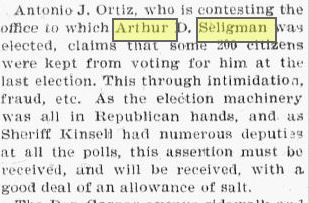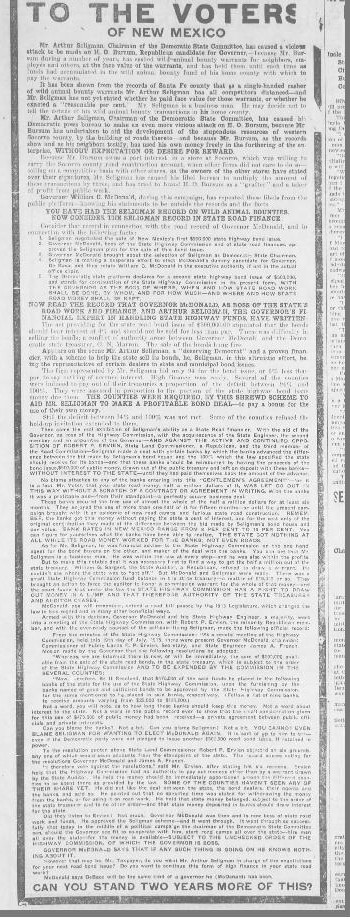My great-grandmother’s younger brother Arthur was the youngest child of Bernard and Frances Seligman, my great-great-grandparents, and the only one who was born in Santa Fe. He rose to the highest heights in New Mexico, elected twice to serve as the governor. His story is another remarkable one—the story of the son of a German Jewish immigrant who less than 80 years after his father first arrived in America was elected governor in a state with a very small Jewish population.
There are many sources outlining Arthur’s life as well as many primary sources. I relied in part on Ralph Emerson Twitchell, Old Santa Fe: The Story of New Mexico’s Ancient Capital (Rio Grande Press 1925), pp. 477-478; the article on Arthur Seligman on the National Governor’s Association website; the article in The Dictionary of American Biography; and the vocesdesantafe website for much of the general background, but also used many primary sources such as newspaper articles, census reports, and school and city directories to fill in the details.
Arthur was born on June 14, 1871. He grew up in Santa Fe and made several trips as a young child on the Santa Fe Trail back East with his mother to visit her family. He attended public school in Santa Fe, and then in 1885 he, along with his older sister Minnie and brother James, traveled across the country to Philadelphia where Arthur, Minnie, and James attended Swarthmore, as had their older sister Eva, my great-grandmother, before them. Arthur then attended Pierce Business College in Philadelphia.
When he returned to Santa Fe after college, he worked as a clerk and then as a bookkeeper at his family’s business, Seligman Brothers. In 1896 when he was 25, he married Frankie E. Harris, usually referred to as Franc.

Cuyahoga County Archive; Cleveland, Ohio; Cuyahoga County, Ohio, Marriage Records, 1810-1973; Volume: Vol 42-43; Page: 489; Year Range: 1892 Sep – 1896 Jul
She was four years his senior and a widow with an eight year old daughter named Richie Harris. Although they were married in Ohio where Franc had been living, they moved to Santa Fe after they married, and Richie took Arthur’s surname as her own. It’s not clear whether Arthur ever legally adopted Richie since she is identified as his step-daughter on the 1900 and 1910 census reports. I am curious as to how Arthur met Franc, but so far I have not been able to find an answer.
On February 14, 1898, Arthur and Franc’s son Otis Perry Seligman was born. On the 1900 census, Arthur listed his occupation as “merchant dry goods.” When the Seligman Brothers business incorporated in 1903, Arthur was named treasurer and secretary of the corporation with his older brother James serving as president and general manager. On the 1910 census, he still listed his occupation as a dry goods merchant.
But at the same time that he was helping to run the business, Arthur was also very involved in local politics. As early as 1893 when he was 22, Arthur was already serving as a clerk in the local elections that year. (“Election Proclamation,” Santa Fe New Mexican (March 23, 1893), p. 4). In 1896 he was elected to be a delegate to the state Democratic Party convention in Santa Fe. (“Democratic Primaries,” Santa Fe New Mexican (May 25, 1896), p. 4) That same year he was also nominated as a candidate on the Populist ticket at their convention in Santa Fe. (“Populists in Council,” Santa Fe New Mexican (October 28, 1896), p. 4)
In 1900 Arthur was a candidate for county commissioner on the Democratic ticket. (“Personal Mention,” Santa Fe New Mexican (October 26, 1900), p. 4) He ended up defeating his Republican opponent in a close race where most Democrats on the ticket lost in the election. (“The Official Count,” Santa Fe New Mexican (November 13, 1900), p.4) In fact, the race was so close that his opponent challenged the results. (“Election Contests,” Santa Fe New Mexican (December 13, 1900), p. 4) His opponent claimed that Arthur had used intimidation to discourage his opponent’s supporters from voting.
Although I could not find a follow-up article regarding this challenge, I assume it was unsuccessful. Arthur served on the County Commission for many years and was soon its chairman.
In 1903 he also served as treasurer of the New Mexico commission to prepare for the St. Louis World’s Fair. (“World’s Fair Commission,” Albuquerque Daily Citizen (June 3, 1903), p.5) In 1905 he was serving as the chairman of the Santa Fe County Commission. In that capacity he was active in arguing in favor of statehood for New Mexico. (“They Want Their Debts All Paid,” Albuquerque Citizen (December 11, 1905), p. 6) He was a delegate to the New Mexico Democratic Convention in 1906. (“Aftermath of Democratic Convention,” Albuquerque Citizen (September 14, 1906), pp. 1, 5)
In April, 1910, Arthur was elected mayor of Santa Fe by 193 votes. (“Democrats Take All in Santa Fe, Arthur Seligman Mayor by a Majority of 193,” Santa Fe New Mexican (April 6, 1910), p. 8) Two years later, however, he was defeated by his Republican opponent for mayor, Celso Lopez. (“Twenty-One Towns Elect Officers,” The Kenna Record (April 12, 1912), p. 8)
New Mexico become a state on January 6, 1912, and Arthur became involved in statewide politics. When the chairman of the state Democratic Party resigned in January 1912, Arthur was named as a potential replacement. (“Democratic State Chairman to Resign,” Santa Fe New Mexican (January 31, 1912), p. 5) A later article, however, indicates that Arthur did not then serve as chairman, but as secretary of the Democratic Party in New Mexico in 1912. (“Congressman H.B. Fergusson Renominated by Democrats,” Las Cruces Sun-News (September 13, 1912), p. 1). In 1912 he was also serving on the Natural Resources Commission (Ancestry.com. Polk’s Arizona and New Mexico pictorial state gazetteer and business directory : 1912-1913. [database on-line]. Provo, UT: The Generations Network, Inc., 2005). He also served as Road Commissioner and was responsible for some important improvements to the roads and bridges in New Mexico. (See, e.g., “Road Bond Deal Finally Closed by Treasurer,” Albuquerque Journal (July 8, 1915), p. 3; there are many other articles about Seligman’s role on the Road Commission on newspapers.com and on genealogybank.com; see also Twitchell, op.cit.)
In September, 1916, he was elected chairman of the State Democratic Party. (“New Mexico State News,” Estrella (September 16, 1916), p. 3). The Democrats did well in the 1916 election in New Mexico, and the Albuquerque Journal praised Arthur’s work as chair:
(“Arthur Seligman’s Work,” Albuquerque Journal (November 12, 1916), p. 6).
The election was not without some controversy, however, as the Republicans ran a rather nasty ad attacking Arthur Seligman:
(Western Liberal (October 27, 1916), p. 7)
The ad insinuated that Seligman had schemed to advance his own interests and that of the banks in the context of a bond issue to finance road improvements when he was serving as Road Commissioner. Although I cannot find any more about these claims and cannot even understand much of what the ad is alleging, it does not appear that this ad hurt Seligman himself or the Democratic candidates in the 1916 election.
In 1920, Arthur was still serving as Chairman of the Democratic Party Committee, but apparently faced some opposition to his continued service. (“M’Adoo in Favor With Democrats,” The Deming Headlight (June 4, 1920), p. 1) However, he defeated that opposition and continued serve as state chairman after the convention. (“Arthur Seligman Chosen Chairman for Another Term,” Albuquerque Journal (August 27, 1920), p. 1)
Despite his heavy involvement in political matters, Arthur still listed his occupation as a dry good merchant on the 1920 census. Franc’s daughter Richie, meanwhile, had married John Whittier March and had had a son George in 1919. Franc and Arthur’s son Otis was working as a bank clerk in 1920 and living with his parents in 1920. In June 1921 Otis married Doris Gardiner.

The Seligman Family in the 1920s Arthur, Doris (Otis’ wife), Mary Ann Gardiner (Doris’ mother) , Franc, and Otis Courtesy of Arthur Scott
The 1920s brought even greater political success to Arthur. By 1921, there was talk that he might be a candidate for governor in 1922. (“Governorship Race May Be Largely Battle of Santa Fe for Both Parties,” Albuquerque Journal (December 21, 1921), p. 1). Although he was not nominated as a gubernatorial candidate in 1922, he was promoted to the national Democratic Committee representing New Mexico. In turn, he resigned as state party chair and was praised by many for his long service on behalf of Democrats in New Mexico although one delegate spoke against him. (“Arthur Seligman Boosted to National Committee,” Albuquerque Journal (February 24, 1922), p. 1)
Strangely, I could not find many news articles mentioning Arthur Seligman between 1923 and 1929 on either newspapers.com or genealogybank.com, although he was still serving as the New Mexico national committeeperson for the Democratic Party during those years according to the few news articles that mentioned him. (E.g., “Santa Fe is for Al Smith,” Estrella (May 12, 1928), p. 3)
Meanwhile, his business career was changing as well. In 1925, he was not only running Seligman Brothers, he was also president of the First National Bank of Santa Fe. (“New Mexico State Items,” Estrella (June 20, 1925), p. 2) Ralph Emerson Twitchell wrote that Arthur had been vice-president of the bank since 1912 and became president in 1924. In the 1928 Santa Fe directory, he is listed only as president of the bank with someone named Evelyn Conway now running Seligman Brothers.
By 1929, Arthur Seligman was already a very successful man both in politics and in business, but he was not done yet, and in 1930 when he was 59 years old, he achieved what would probably have been amazing to his parents, both of whom had died many years before—he was elected governor of New Mexico.
More on that in my next post.






What an amazing story. It boggles my mind how seemingly easy people traveled with no super highways or airplanes.
B
Sent on the new Sprint Network from my Samsung Galaxy S®4.
LikeLike
It is amazing—going back and forth by wagon, then eventually by train, later by car. In some later articles, there is mention of Arthur flying places and that he loved flying. Perhaps you and he could have been buddies!
LikeLike
Pingback: Arthur Seligman, Governor of New Mexico: Part II « Brotmanblog: A Family Journey